Outsourcing to Czechia

How much does it cost to hire developers in Czechia?
Dec 2nd 25 - by Devico Team
Find out how much it costs to hire software developers in Czechia in 2025. Compare hourly rates, roles, and factors that impact pricing.
Hire
Hire by role
Hire Front-end developers
Hire Back-end developers
Hire Full-stack developers
Hire Android developers
Hire iOS developers
Hire Mobile developers
Hire AI engineers
Hire ML engineers
Hire Automation QA engineers
Hire Blockchain developers
Hire Data engineers
Hire Cloud engineers
Hire by skill
Hire JavaScript developers
Hire TypeScript developers
Hire Ruby on Rails developers
Hire React Native developers
Hire Flutter developers
Hire Golang developers
Hire React.js developers
Hire Python developers
Hire PHP developers
Hire .NET developers
Hire Java developers
Hire Laravel developers

API development
December 26, 2024 - by Devico Team
Summarize with:
API is getting bigger than ever, building strong bridges between businesses, as well as businesses and customers. The rapid evolution of API showcases many trends that are currently used by developers and entrepreneurs to make the use of API more efficient and expand it so that it covers even more spheres and industries than before.
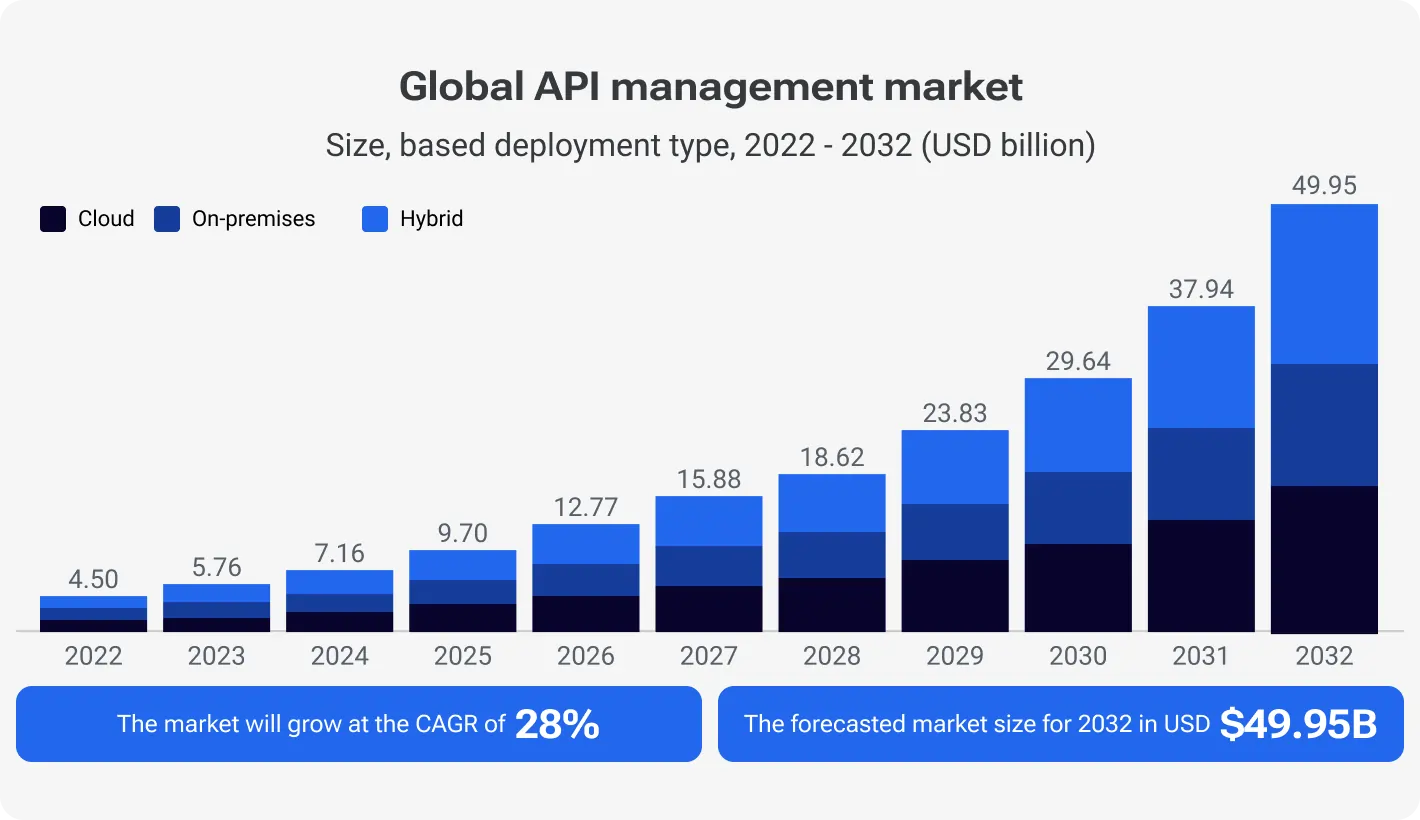
In this article, we aim to explore the top trends in API development that entrepreneurs, business leaders, and developers should be aware of. We’ll explore key innovations such as the rising adoption of GraphQL, serverless architectures, enhanced API security, the growth of microservices, API management platforms, automated API testing and monitoring, and the concept of API as a standalone product. Keep reading to find out how your business can benefit from each of these innovations.
The development and spread of APIs is not frozen in place: according to the Slashdata Developer Economics Survey 19th edition, nearly 90% of developers are using APIs in some capacity. New trends are implemented on a daily basis in order to revolutionize and simplify the integration and use of APIs, making them accessible to more industries and audiences.
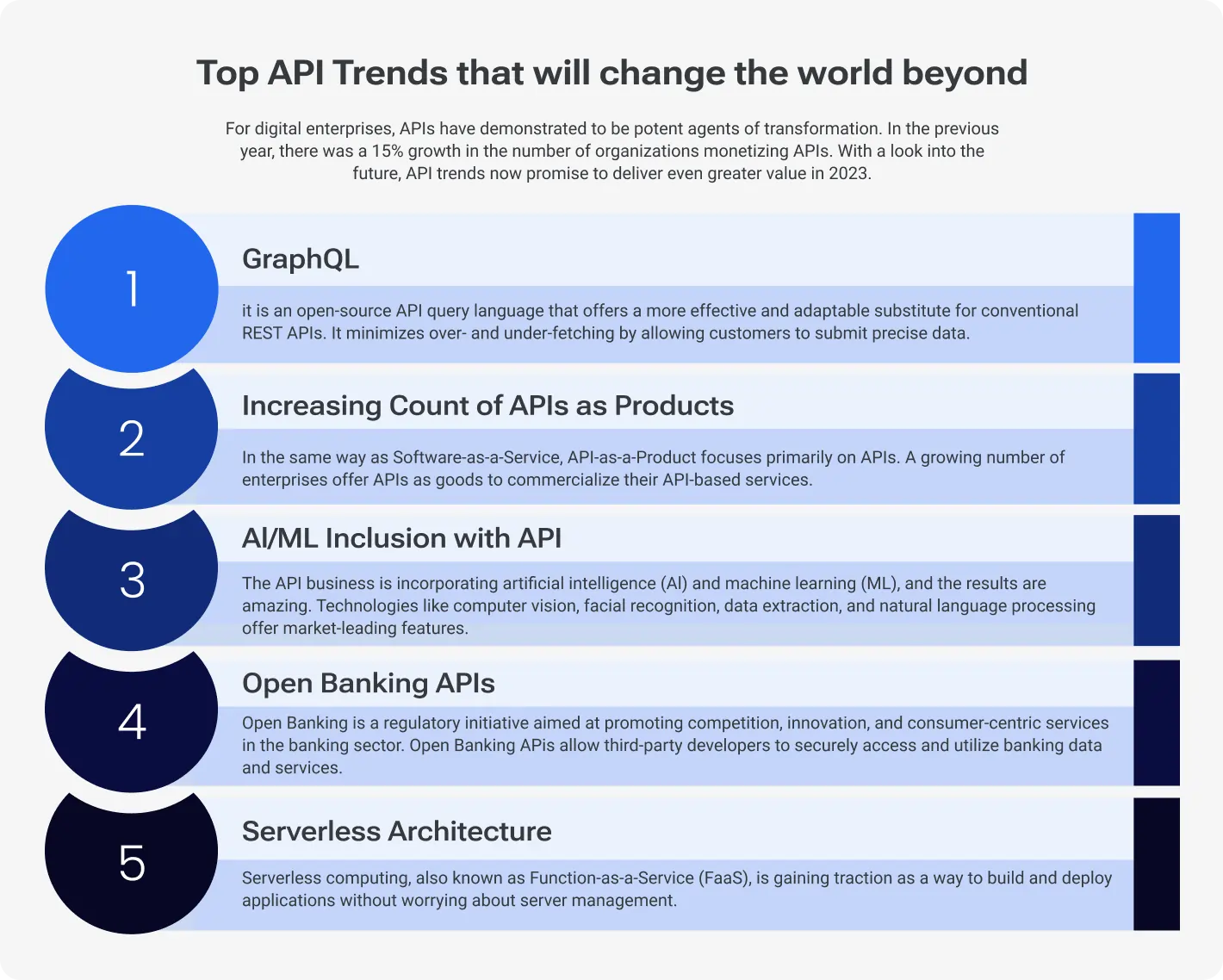
Developers and business owners across various fields study the potential of APIs closely, refining features already implemented and thinking up new ways to maximize performance through the use of automated tools and utilities.
Your API roadmap: Strategies for successful deployment
Below are our expert views on the current trends in API development, their main advantages, and the successful examples of their integration and use by big corporations.
GraphQL is the type of API that deals with all user requests within one interaction. It was developed by Facebook. In GraphQL, clients can specify exactly what data they need. This reduces over-fetching (getting unnecessary data) or under-fetching (not getting enough data) compared to traditional REST APIs. In REST, you'd often make multiple requests to different endpoints to get all the necessary information, while GraphQL allows fetching multiple related resources in a single request.
Speaking of flexible queries, GraphQL lets users pick their own queries, enabling them to retrieve only the information they came for, with no unnecessary details. For example, you can fetch a profile of a certain user along with all their followers in a single request.
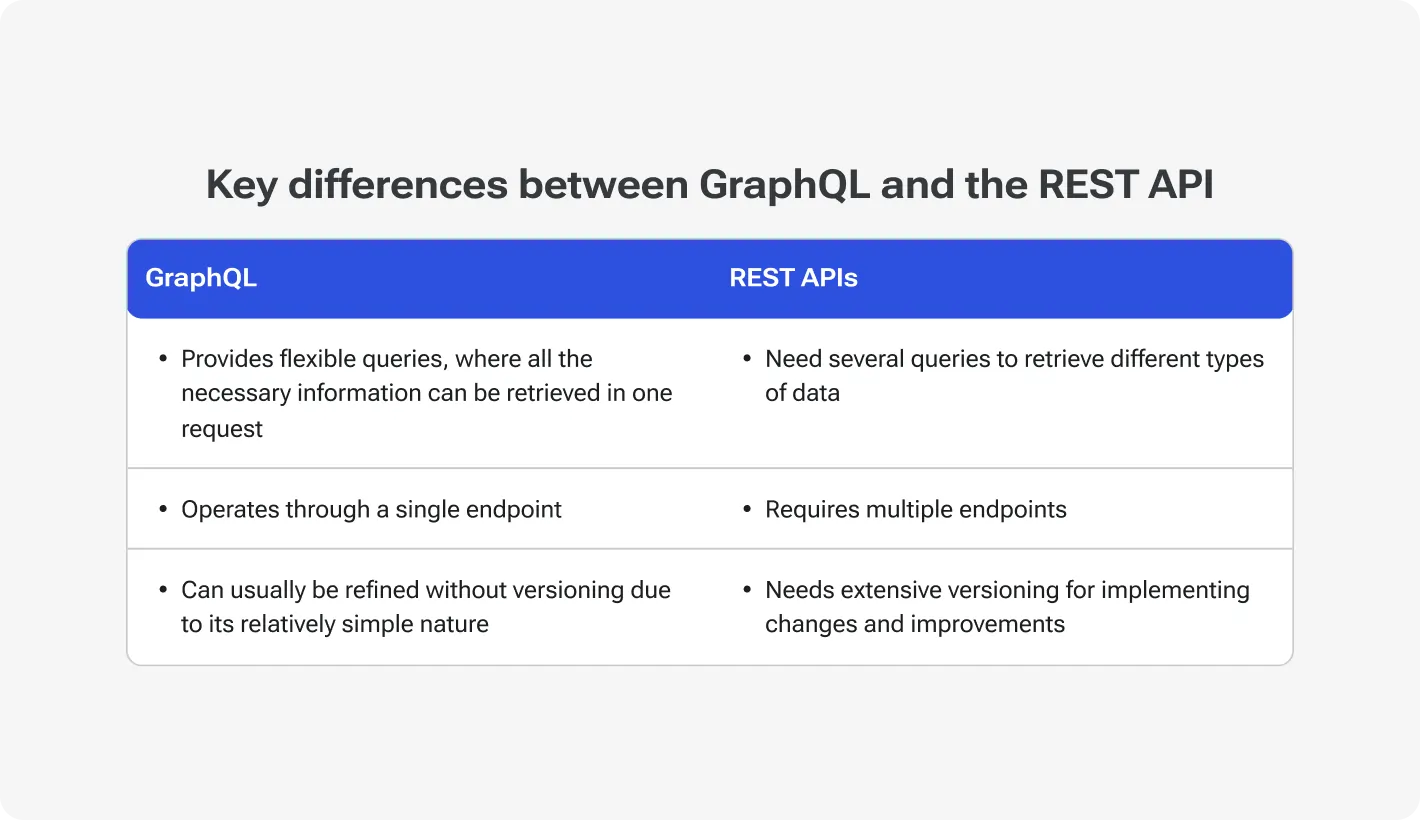
An example of a company successfully using GraphQL is Facebook, which гoriginally developed this API type to power its mobile apps. The REST architecture was proven inefficient for those apps because it needed to access multiple data in a single view, which was too slow to be performed using REST.
With GraphQL, Facebook was able to streamline its data-fetching process. Now, clients can request precisely the data they need, thus reducing the number of requests and improving performance. Besides, Facebook constantly refines its GraphQL API, implementing new security measures and enhancing the overall performance and response speed.
Serverless Computing is a cloud computing execution model in which the cloud provider dynamically manages the allocation of machine resources. Instead of running and maintaining servers, developers write code and deploy it in the form of "functions" that are executed on demand. Thanks to this, developers optimize API creation, saving time they would’ve otherwise spent on studying and organizing the underlying technology.
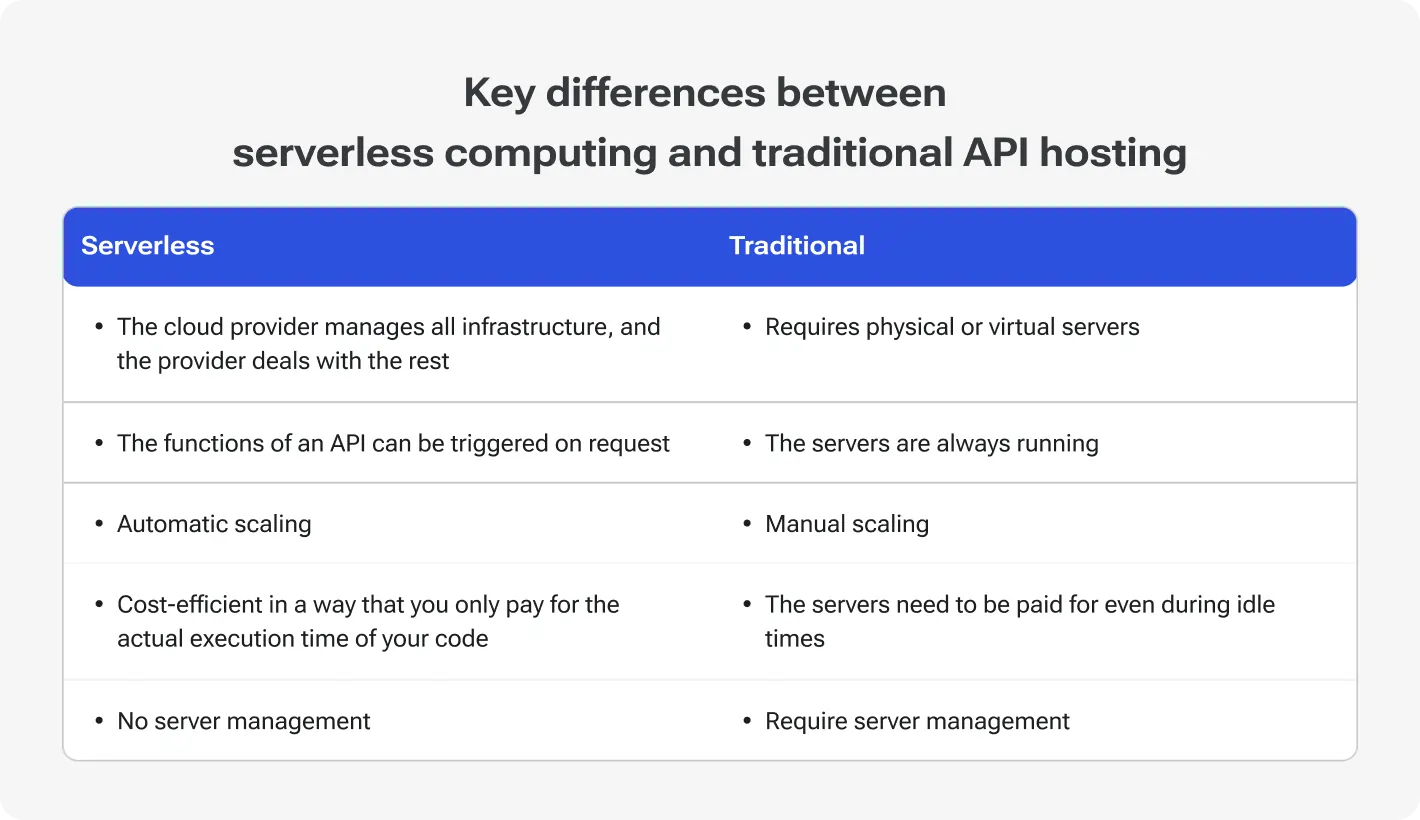
As you can see, serverless APIs can save their developers significant amounts of time while being cost-effective and relatively simple to use. One of the prominent examples of a company successfully deploying a serverless architecture for its APIs is Coca-Cola.
Coca-Cola deployed serverless APIs on AWS Lambda to power their vending machine payment systems. In the traditional model, they would have needed to maintain servers that constantly ran to handle user payments, track inventory, and process transactions. With serverless computing, Coca-Cola was able to save costs because the functions of the API were only triggered when customers interacted with their vending machines.
API Security has become one of the key concerns due to the cyber threats that are targeting APIs, especially those of the big companies or platforms. Some of the possible reasons for this are the adoption of cloud services, microservices, and mobile applications, which can be, especially at early stages of development and implementation, particularly vulnerable to cyber-attacks.
Security is now the focus of attention due to the ever-growing increase in API usage across the world, the complexity of modern APIs and their sophisticated functions, high-profile breaches of API, and cyber threats becoming more complex and harder to oppose.
As a result, more and more trends spring up in the security sector. Mainly, API gateways, OAuth 2.0, and rate limiting. These tools allow us to automate processes like security reinforcement and audit, and limit the number of user requests per timeframe so that they don’t become overwhelming and harm the performance of an API.
API gateways are a core component of modern API management and security. They act as intermediaries between clients and services, setting forth security policies such as authentication, rate limiting, and traffic monitoring. API gateways filter requests and ensure that only authorized and valid requests pass through;
OAuth 2.0 is an open standard for access delegation commonly used for token-based authentication. It allows third-party applications to access resources on behalf of a user while not exposing their personal data. OAuth 2.0 is widely adopted for API security as it provides secure mechanisms for authorizing API access;
Rate limiting controls the number of API requests a client can make in a certain time period. In this way, it helps prevent abuse or overuse of APIs. Throttling is the process of slowing down or limiting the rate of API requests when the rate limit is reached. Both methods are important in balancing the API at the moments of high request load.
One of the examples of a company successfully implementing advanced API security measures is X (formerly Twitter). It has evolved its security model over the years thanks to using OAuth 2.0 for authentication of third parties, strict rate limiting for API requests, two-factor authentication (2FA), and traffic encryption via HTTPS/TLS.
Microservices architecture and the API-first approach are key methods of modern software development, putting an emphasis on scalability and faster development cycles. First and foremost, they allow for the creation of more independent, safe, and scalable APIs that are, at the same time, not difficult to maintain, improve, and fix in case of errors or bugs.
In microservices architecture, an application is split into smaller independent services, and each of them accounts for a specific function. Each piece also has its own database and communicates with others through APIs. Their key benefits are:
Independence: each piece can be developed, changed, or enhanced independently, without affecting the whole system;
Modularity: each microservice focuses on a single function, which makes the whole system easier to maintain;
Decentralized data management: microservices manage their own databases, which reduces the risk of interchanges or faults in the data processing;
Resilience: whenever a single microservice is targeted by a cybersecurity attack, it doesn’t cause the failure of an entire application, which, in the long run, makes the whole ecosystem more resilient.
In the API-first approach, APIs are put at the top of the development process. Instead of making a product first and then an API around it, developers start with structuring an API and then using it to chain together different services or backend and frontend together. When API is the primary focus of attention, it is built to be more resilient and bug-free in the first place.
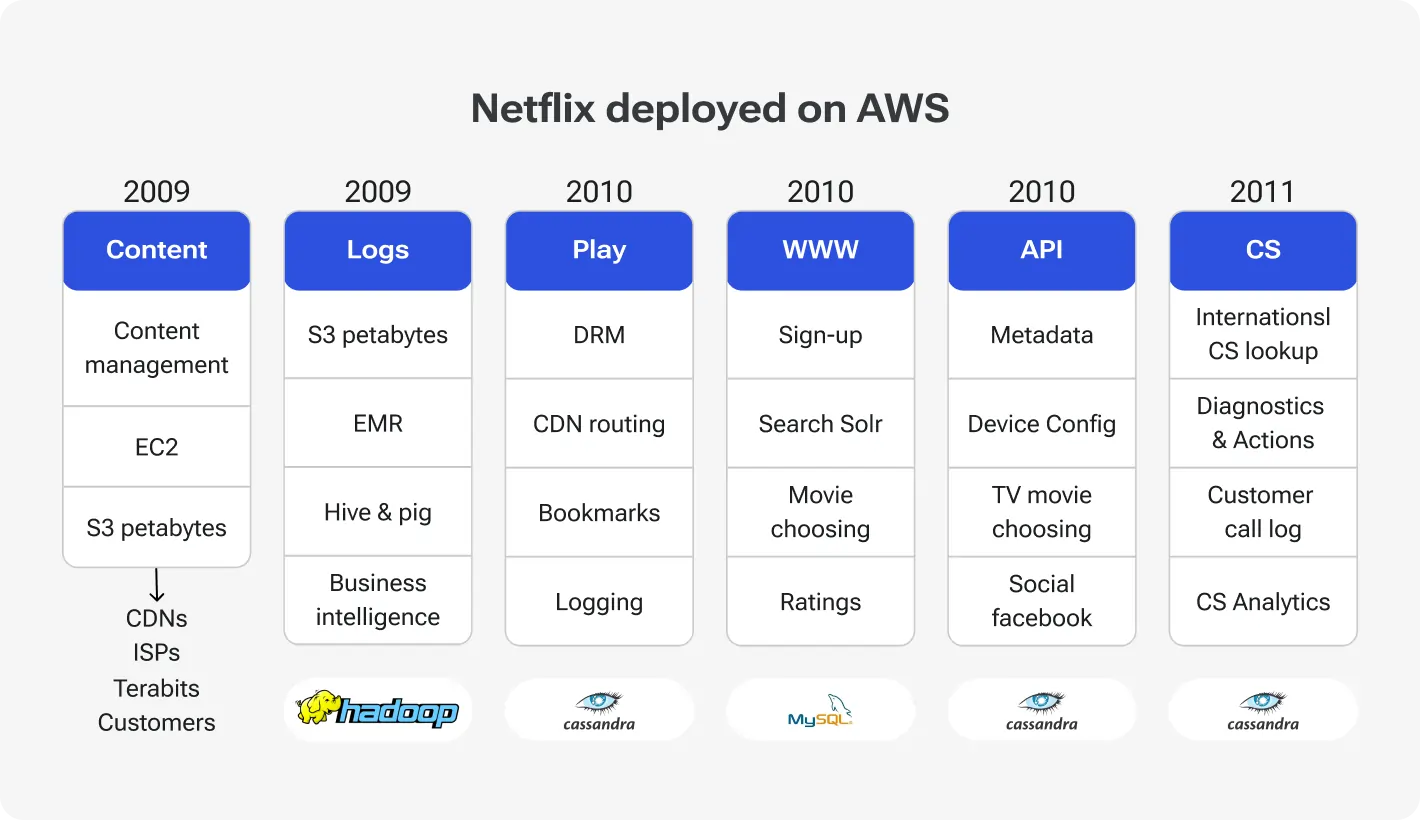
One of the examples of huge companies using microservices and an API-first approach simultaneously is Netflix. It is evident that the platform has massive traffic, which spikes during popular show releases. Henceforth, microservices architecture helps Netflix scale each service independently and reduce the overuse of traffic. Netflix also used the API-first approach to align the work of its frontend and backend teams: in this way, it can test its frontend services while the backend features are still being refined.
API Management Platforms play a crucial role in handling the entire lifecycle of APIs, from creation to deployment, security, monitoring, and versioning. Thanks to these platforms, developers obtain tools and services needed to manage, protect, scale, and version their APIs.
API lifecycle management includes such stages as designing the API contract, developing and deploying an API, ensuring its security, monitoring and analyzing its performance and use, managing load through scaling, and versioning an API in order to ensure backward compatibility when applying changes.
The most popular API management platforms currently are Apigee, MuleSoft, and AWS API Gateway:
Apigee is one of the most widely used API management platforms, known for its robust security, analytics, and developer portal features. It’s particularly favored by large companies because it offers such features as traffic management, API analytics, threat protection, etc;
MuleSoft’s Anypoint Platform is used for building, deploying, and managing APIs and integrations. It enables organizations to connect data across applications, systems, and devices. It provides both API management and integration services, making it a powerful tool for building enterprise-grade APIs;
AWS API Gateway is a fully managed service that makes it easy to create, publish, and secure APIs at any scale. It integrates seamlessly with other AWS services and provides tools for managing traffic, authorizing requests, and monitoring API usage. AWS API Gateway is particularly popular for serverless architectures, where APIs trigger AWS Lambda functions.
Salesforce adopted MuleSoft's Anypoint Platform to manage its API-driven architecture across different products and internal systems. Salesforce’s core platform relies heavily on APIs for data integrations between different services like Sales Cloud, Service Cloud, and third-party applications. Before MuleSoft, managing these integrations was complex, but now multiple connectors are replaced for one comfortable and all-encompassing system.
Automated API testing and monitoring are essential for ensuring API reliability, performance, and securityю As organizations adopt microservices, cloud-native architectures, and third-party integrations, constant testing, and real-time monitoring are getting more important than ever.
Why do you need to automate API testing and monitoring?
Ensuring functionality. Automated tests help validate that APIs behave as expected. This includes testing various endpoints, input parameters, and return values to ensure that every part of the API delivers the correct responses. Functional tests can catch bugs early, preventing errors from being deployed to production environments.
Maintaining API contracts. APIs often serve multiple clients (e.g., front-end applications, and third-party integrations), so it's critical to maintain a consistent contract between the API provider and consumers. Automated testing ensures that any changes to the API (e.g., new versions or feature updates) don’t break existing integrations or functionality.
Improving development speed. Automated tests provide fast feedback on changes made to the API, allowing developers to detect issues earlier in the development process. This reduces manual testing efforts and accelerates the overall development cycle. Tests can be run as part of a continuous integration (CI) pipeline to ensure every code commit is tested before being deployed.
Regression prevention. As APIs evolve, there’s a risk of introducing bugs in previously working features. Automated tests help prevent regression by continuously verifying that new updates do not break existing functionality. This is especially crucial in large applications with many interconnected services.
Supporting multiple environments. APIs are often deployed across multiple environments (development, staging, production), and automated tests ensure consistent behavior across these environments. This guarantees that what works in development will also work when produced and released.
Some of the most widely used tools for API testing include Postman, SoapUI, Newman, and Karate. As for real-time API monitoring tools, developers most often resort to Prometheus, Grafana (or a combination of both), Datadog, New Relic, and AWS CloudWatch.
The use of these testing and monitoring tools allows for constant improvement of the API’s functionality, testing it not only for common cases but also for extreme errors, synthetic monitoring, and setting thresholds and alerts.
Spotify actively uses APIs to deliver new music releases, recommendations, and playlists to millions of users simultaneously and in real-time. Since the service has a complex API ecosystem, it has to rely heavily on services like Postman and Newman for automated testing of its APIs. Besides, Spotify uses a combination of Prometheus and Grafana for real-time API monitoring and Datadog for monitoring distributed traces across its microservices architecture.
As a result, Spotify saves time on manual API testing and enhances development by detecting bugs early and ensuring that new features are developed and released without causing harm to the existing functionality.
Treating APIs as standalone products involves designing, developing, and managing APIs not just as internal technical components but as products in their own right and with their own values. This approach views APIs as products that external developers, partners, and customers can consume, often for specific use cases or services.
APIs as products are widely used across different industries and business sectors. One of the prominent examples of such a development is Twilio’s native API. Twilio is one of the most famous companies that have successfully implemented an API-as-a-product strategy. They provide cloud communications APIs that enable developers to add voice, video, SMS, and messaging functionality to their applications. As a result, Twilio experienced significant revenue growth due to its API-as-a-product strategy. The company's API-driven business model has scaled globally, with thousands of developers and companies integrating Twilio’s APIs into their applications.
In order to achieve similar results, you must study the core traits and benefits of API-as-products. Let us dwell on it in more detail.
APIs as individual products have their own set of characteristics and features. You must get acquainted with them before working on your own independent API.
Just like any product, an API needs to provide value to its users. This means the API must solve a specific problem or unlock new capabilities for developers or businesses. For instance, an API might offer access to a company’s data, services, or infrastructure, enabling users to build on top of that offering.
Traditional APIs are often designed for internal use, connecting different systems or services within an organization. However, when an API is treated as a product, it is built with external developers or businesses in mind. This includes providing well-documented, stable, and secure access for third parties to integrate with the API.
APIs as products often have a direct or indirect monetization strategy. Direct monetization involves charging for API usage through subscription tiers, pay-as-you-go pricing, or revenue-sharing models. Indirect monetization might include offering the API for free but using it to drive other business goals, such as customer acquisition or promoting the use of core services.
APIs as products require a comprehensive approach to management, including design, deployment, versioning, and support. They must be maintained, updated, and monitored just like any software product. This includes offering strong documentation, developer support, security measures, and performance guarantees.
Since external developers are often the primary users of productized APIs, delivering a great developer experience is critical. This includes providing easy-to-follow documentation, sample code, SDKs, and developer tools, as well as setting up developer portals for managing API keys, monitoring usage, and troubleshooting issues.
Treating an API as an independent product can possibly improve the revenue streams for a business. Here are some examples of how APIs-as-a-product drive innovation and revenue for their developers and end-users.
When a company offers its APIs as products, it opens the door to third-party developers, startups, and partner organizations who can build innovative products and services on top of the API. This creates an ecosystem where new applications can emerge, driving innovation without requiring the company to develop everything in-house. For example, a payment processing API might inspire developers to create specialized payment applications for specific industries.
APIs as products can generate revenue directly through usage-based pricing models. APIs are often priced based on the number of requests or the volume of data processed. For example, a company might offer free access to its API up to a certain limit and then charge for higher usage. This allows companies to scale their revenue as their API usage grows.
APIs allow businesses to quickly launch new services or features. Instead of building entire applications from scratch, companies can leverage their APIs to allow others to integrate, build, or extend their offerings. This leads to faster marketing for new products and can be a competitive advantage.
Many organizations have valuable data (e.g., financial, weather, or healthcare data) that can be monetized through APIs. By offering API access to this data, companies can generate revenue by enabling external businesses to use this data for analytics, reporting, or building their custom applications.
API-as-a-product strategies make it easier for partners and third-party developers to integrate with a company's systems. This can lead to deeper partnerships, where API consumers build valuable extensions or services on top of the company’s base offerings. This can also expand the reach of the company's services to new markets or sectors.
APIs provide a scalable and globally accessible interface for delivering services or data. By offering APIs, businesses can expand their operations internationally without setting up additional infrastructure in new markets. APIs allow companies to serve clients anywhere in the world via a consistent and standardized interface.
How to take the most out of the current API development trends and naturally implement them for the benefit of your own business?
How to build a better user experience through API integration
There are several tips we can think of:
Training. Study the essence and underlying technology behind every trend before implementing it. As an entrepreneur, you will want to hire a team of skilled developers who have experience implementing these features for API development.
Resource allocation. Integrating trends costs both time and money, which experienced entrepreneurs understand. Henceforth, allocating your funds and workforce wisely is key to successful trend integration without undesirable expenses.
Assessment. It is important to assess the resources and tools you currently have employed in the API development process. Through testing and studying the results, you can detect possible errors or loose ends in the functionality of particular features.
Prioritization. Once you assess the current performance of your API, prioritize those spheres that could use some improvement. You might not want to follow all trends at once since it could be harmful both for your budget and resources. Instead, work on the aspects that fall behind first and improve them by using the tools described in this article.
Communication. Make sure to build connections with developers or business partners who have already tried some of the current trends while developing their own APIs. Let them share their experience and professional recommendations first-hand.
Cooperation. If you need a helping hand in developing and implementing your API, consider getting in touch with Devico. We have years of experience assisting entrepreneurs and developers with API development, and our solutions are tailor-made for specific projects and businesses.
The trends in API development like GraphQL adoption, serverless architecture, API security, microservices, API management platforms, automated API testing, and the API-as-a-product approach facilitate the process of building and integrating APIs. Given that API creation is a multifaceted process, these tools are indispensable for keeping the performance of your API on par with the industry standards.
Rethink your current choices in API development and consider which trends you can implement to improve its performance. If you want to explore the opportunities of these tools for the benefit of your company, get in touch with Devico. A team of expert technicians will help you define the best course of action for improving your existing API or building a new API for your platform or application from scratch.
Outsourcing to Czechia

Dec 2nd 25 - by Devico Team
Find out how much it costs to hire software developers in Czechia in 2025. Compare hourly rates, roles, and factors that impact pricing.
Outsourcing to Czechia

Nov 25th 25 - by Devico Team
Compare Czechia and Poland for software outsourcing in 2025. Discover costs, talent, infrastructure, and which country fits your project best.
Outsourcing to Czechia

Nov 18th 25 - by Devico Team
A complete guide to outsourcing software projects to Czechia, learn about costs, talent, benefits, and how to build successful partnerships in 2025.